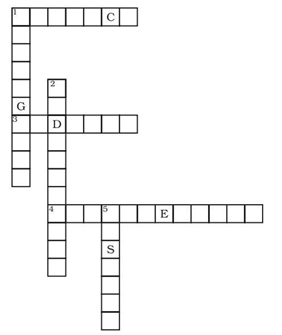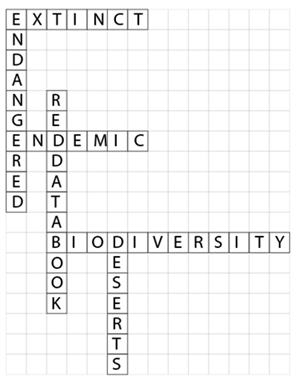NCERT Solutions for Class 8 Science Chapter 5 Conservation of Plants and Animals help students to clear all their doubts. These solutions provide you with the answers to all the questions given in the NCERT textbook. CBSE Class 8 Science Chapter 5 Solutions is prepared by expert teachers as per the latest CBSE syllabus and guidelines.
Solving NCERT Solutions will help you to understand the concepts related to Conservation of Plants and Animals. NCERT Solutions for Class 8 Science Chapter 5 contains an in-depth explanation of each question of NCERT Science textbook. These solutions cover important concepts in different patterns like MCQs and short answer questions, worksheets and more and help you top score good marks in the exam.
Class 8 Science Conservation of Plants and Animals Questions and Answers
Exercise Questions
Question 1: Fill in the blanks.
(a) A place where animals are protected in their natural habitat is called _________.
(b) Species found only in a particular area is known as _______.
(c) Migratory birds fly to faraway places because of __________ changes.
Answer: (a) A place where animals are protected in their natural habitat is called wildlife Sanctuary.
(b) Species found only in a particular area is known as endemic .
(c) Migratory birds fly to faraway places because of climatic changes.
Question 2: Differentiate between the following:
(a) Wildlife sanctuary and biosphere reserve
(b) Zoo and wildlife sanctuary
(c) Endangered and extinct species
(d) Flora and fauna
Answer 2: (a) Wildlife sanctuary and biosphere reserve
| Wildlife Sanctuary | Biosphere Reserve |
| An area protected for animals where animals can live in their natural habitat is known as a wildlife sanctuary. | An area which is conserved to protect the biodiversity and culture of that area is known as a biosphere reserve. |
| In these sanctuaries hunting, poaching, grazing, felling trees etc. are strictly prohibited. | A biosphere reserved is consisted of many protected areas like sanctuaries, national parks, lakes mountains etc. |
| There are about 440 wildlife sanctuaries in India. | There are 15 Biosphere reserves in India. |
| Eg: Corbett national park | Eg: Nilgiri Biosphere reserve |
(b) Zoo and wildlife sanctuary
| Zoo | Wildlife Sanctuary |
| It is a place where animals live in artificial habitat. | It is place where animals live in natural habitat. |
| The animals are protected for public view and they are spread in small areas. | The animals are protected and conserved in very large areas. The areas are prohibited for hunting, grazing, felling trees etc. |
(c) Endangered and extinct species
| Endangered Species | Extinct Species |
| The species which are at the verge of extinction and which are required to be protected and conserved are known as endangered species. | The species which no more exist on the earth are known as extinct species. |
| Example: tiger, wild buffalo etc. | Example: dinosaurs. |
(d) Flora and fauna
| Flora | Fauna |
| All plant life occurring in an area is known as Flora. | All animal life occurring in an area is known as Fauna. |
| Example: Sal, teak, mango, jamun, silver ferns, arjun, etc. are the flora | Example: Chinkara, blue-bull, barking deer, cheetal, leopard, wild dog, wolf, etc. are the fauna. |
Question 3: Discuss the effects of deforestation on the following:
(a) Wild animals
(b) Environment
(c) Villages (Rural areas)
(d) Cities (Urban areas)
(e) Earth
(f) The next generation
Answer 3: (a) Wild animals: The natural habitat of the animals is destroyed by deforestation. Without the natural habitat the animals are left with no place to live and breed. As a result of this many animals are at the verge of extinction.
(b) Environment: Deforestation has resulted in Global warming. Carbon dioxide is not absorbed by plants and it gets accumulated in the atmosphere. It has an adverse effect on our ecosystem.
(c) Villages (Rural areas): The rural areas largely depend on forests for fuel, fruits, wood etc. Deforestation has reduced their resources and the uninhabited animals are also a danger for the villagers
(d) Cities (Urban areas): Cities are not directly affected by deforestation. But the changes in the climate results in calamities like flood and droughts which affect the cities also. It also leads to global warming.
(e) Earth: Deforestation has converted the fertile lands into deserts. The natural calamities like floods and droughts are also the result of deforestation. The climate of the earth has been changed due to deforestation.
(f) The next generation: Deforestation has affected our climate very much. Many species are at the verge of extinction because of deforestation and some species are already extinct. The next generation may not be able to see many beautiful and attractive fauna and flora. It may have to suffer from the effects of global warming, no fuel and no paper etc.
Question 4: What will happen if:
(a) we go on cutting trees.
(b)the habitat of an animal is disturbed.
(c) the top layer of soil is exposed.
Answer 4: (a) We go on cutting trees: If we go on cutting trees, rainfall and fertility of the soil will decrease and the changes of natural calamities will increase. It will also lead to a decrease in water holding capacity of the soil which will result in floods. Animal life will also be affected.
(b) The habitat of an animal is disturbed: The survival of the animals will become difficult it their natural habitat is disturbed. They will not have any space to live and to breed. As a result they will not survive and also because of scarcity of food the animals have started wandering in the nearby villages and targeting domestic animals as their prey.
(c) The top layer of soil is exposed: If the top layer of soil is exposed it will wash away with water. The removal of the top layer will gradually convert the fertile land into deserts. Moreover, the soil washed away with water will be deposited in the river bed resulting in decreasing the depth of rivers. The chances of floods will increase many folds.
Question 5: Answer in brief:
(a) Why should we conserve biodiversity?
(b) Protected forests are also not completely safe for wild animals. Why?
(c) Some tribals depend on the jungle. How?
(d) What are the causes and consequences of deforestation?
(e) What is Red Data Book?
(f) What do you understand by the term migration?
Answer 5: (a) We should conserve biodiversity because it is very important for all living organisms and for the environment. We should conserve biodiversity to save it from becoming extinct.
(b) Protected forests are not completely safe for wild animals because poachers have found access in these areas and killing animals. There is a need to make strict rules against poaching and trespassing.
(c) Some tribals are still dependent on the jungle for their food, fuel, wood, shelter etc. They live in forests and are dependent on them.
(d) The main cause of deforestation is growing urbanization and industrialization. Need for more land and resources have led to the cutting down of forests. The consequences of deforestation are desertification and natural calamities. It has also rendered many species of plants and animals unprotected and un-conserved.
(e) Red Data Book keeps the record of all the endangered animals and plants. Different record books are maintained for endangered animals and endangered plants.
(f) For the purpose of breeding and specific purposes, some species of birds and animals move from their habitat to some other habitat. The birds move to far away areas every during a particular time because of climatic changes and return to their original habitat after some time. This periodical of some species is known as migration.
Question 6: In order to meet the ever-increasing demand in factories and for shelter, trees are being continually cut. Is it justified to cut trees for such projects? Discuss and prepare a brief report.
Answer: The ever increasing demand in factories and for shelter, trees are being continually cut. If we have to retain our green wealth for generations, plantation of more trees is the only option. Cutting of trees can only be justified when reforestation is done.
Reforestation is the restocking of destroyed forests by planting new trees. The trees planted should be of the same species that are generally found in the forests. We should plant as many trees as we cut. Reforestation can take place naturally also if the land is left undisturbed. The forests will establish itself over a period of time.
We have damaged our forests to such an extent that it is difficult to retain the green wealth for our future generations. So it is very important to plant more trees and to find out ways of recycling and restoring our natural wealth.
Question 7: How can you contribute to the maintenance of green wealth of your locality? Make a list of actions to be taken by you.
Answer: The green wealth of the locality is the responsibility of every resident. We should grow more and more plants in the locality. The resident should work together to conserve the green belt of the locality. Also, they should be taught about the consequences of deforestation and global warming.
I plant trees in my locality. I also teach the small children and encourage the slogan one man one tree every year, so that every resident plants at least one tree in a year and takes care of it.
Question 8: Explain how deforestation leads to reduced rainfall.
Answer: Plants need carbon dioxide for photosynthesis. Fewer trees would mean that less carbon dioxide will be used up resulting in its increased amount in the atmosphere. This will lead to global warming as carbon dioxide traps the heat rays reflected by the earth. The increase in temperature on the earth disturbs the water cycle and may reduce rainfall.
Question 9: Find out the information about the national parks in your state. Identify and show their location on the outline map of India.
Answer: Do yourself according to your state.
Question 10: Why should paper be saved? Prepare a list of ways by which you can save paper.
Answer: Paper is used in our day to day life. Thousands of trees are cut to fulfil the demand for paper. If the trees are being cut for paper, there maybe one day we will be left with no trees. So paper should be saved and should be used intelligently. The ways in which we can save paper are:
- We should recycle the waste paper.
- We should not litter paper here and there.
- Paper should be sent through proper channel for recycling.
- We should not tear our old books and donate it to poor children so that they can reuse those books.
- We should encourage buying recycled paper products.
- We should avoid taking paper bags from the shops, instead we should carry jute bags.
Question 11: Complete the word puzzle:
Down
1. Species on the verge of extinction.
2. A book carrying information about endangered species.
5. Consequence of deforestation.
Across
1. Species which have vanished.
3. Species found only in a particular habitat.
4. Variety of plants, animals and microorganisms found in an area.

Answer:
